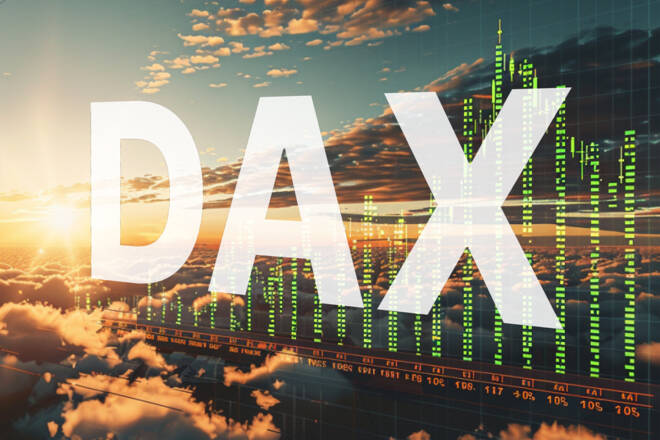Advertisement
Advertisement
Dax Index News: Forecast Hinges on US-EU Deal, German Data, and Fed Commentary
By:
Key Points:
- DAX fell 0.61% as EU-US trade concerns flared ahead of Trump’s August 1 tariff deadline on German exports.
- German factory orders plunged 1.4% in May, with domestic orders down 7.8%, fueling concerns over growth.
- Trump’s Liberation Day tariffs could spike to 50%, threatening DAX stability and investor confidence.
DAX Drops as Trump’s July 9 Deadline Looms
DAX turned lower as the EU failed to strike a trade deal with the US ahead of a new August 1 tariff deadline. The DAX dropped 0.61% on Friday, July 4, reversing Thursday’s 0.61% gain to close at 23,788.
On Sunday, July 6, President Trump extended the 90-day pause on the Liberation Day (April 2) tariffs from July 9 to August 1. However, the US administration plans to send tariff letters out or ink trade deals by July 9.
While the EU is aiming for an in-principle agreement on tariffs, uncertainty about the US stance on such a proposal left investors on a cautious footing. Failure to reach an agreement by the deadline could expose German exporters to 50% tariffs on goods bound for the US. Current tariffs include 25% on autos, 50% on steel and aluminum, and a sweeping 10%.
German Factory Orders Plunge but Not Because of Tariffs
A sharper-than-expected slide in German factory orders contributed to the session losses. Factory orders dropped 1.4% in May, reversing a 1.6% rise in April. Despite US tariffs, overseas orders rose 2.9%, while orders from within the Euro area tumbled 6.5%. Notably, domestic orders plunged 7.8%.
Oliver Rakau, Chief German Economist and ECB Commentator at Oxford Economics, remarked:
“Tempting to make the link to US tariff impact. But given the strength of factory orders from non-eurozone countries, the narrative would have to be sustained tariff front-running partially offsetting domestic weakness.”
Sector Snapshot: Auto and Bank Stocks Stumble
Investor concerns about the EU avoiding tariff hikes weighed on auto stocks. Porsche slid 1.67%, with Volkswagen and Mercedes-Benz Group posting losses of 1.19% and 1.01%, respectively.
Concerns about the economic outlook weighed on bank stocks, with Deutsche Bank dropping 1.55%.
Meanwhile, Rheinmetall surged 3.33% after Deutsche Bank and JPMorgan lifted their price targets on the stock.
German Industrial Production in Focus
On Monday, July 7, industrial production figures from Germany come into focus as the EU pushes for an ‘in principle’ trade agreement. Economists forecast industrial production to decline 0.5% month-on-month in May after a 1.4% fall in April.
A lower reading would align with the recent trend in orders and waning demand, signaling a weakening economic backdrop. Meanwhile, an unexpected rise in production could boost demand for DAX-listed stocks.
Although production data will impact sentiment, trade developments remain the dominant catalyst. Avoiding Liberation Day tariffs and progress toward removal of existing levies could fuel demand for DAX-listed stocks. On the other hand, failed talks and tariff hikes would likely pressure the DAX.
Fed Speakers and Trade Talks in the Spotlight
Later in the July 7 session, investors should track Fed reactions to Thursday’s US Jobs Report.
Outlook: Key Catalysts for the DAX
The DAX’s near-term trajectory depends on US-EU trade developments, key data from Germany, and central bank signals.
- Bullish Case: A US-EU trade agreement, upbeat German data, and dovish central bank signals could send the DAX toward 24,000.
- Bearish Case: Failed US-EU trade talks, weak production numbers, or hawkish central bank cues may pull the DAX toward the 50-day EMA. A break below the 50-day EMA could expose the 23,000 support level.
At the time of writing on July 7, the DAX futures rose 11 points, while the Nasdaq 100 was down 113 points. Futures markets signaled a choppy start to the week as tariff uncertainty tests sentiment.
DAX Technicals
Despite last week’s 1.02% loss, the DAX remains above the 50-day and 200-day Exponential Moving Averages (EMA), indicating bullish momentum.
- Upside Target: A breakout above 24,000 could pave the way to the June 30 high of 24,121. A sustained move through 24,121 may enable the bulls to target the June 5 high of 24,479.
- Downside risk: A break below the 50-day EMA and 23,500 could expose the crucial 23,000 support level.
The 14-day Relative Strength Index (RSI), at 52.29, indicates the DAX could rise to 24,479 before entering overbought territory (RSI > 70).
German Economic Data, Trade Headlines, and Central Bank Rhetoric
Traders should closely track US-EU trade headlines and central bank guidance. The threat of Liberation Day tariffs would likely impact demand for German goods and the DAX. On the other hand, a trade deal could fuel a DAX breakout on market relief. Trade developments will have greater weight than economic data and central bank commentary.
Explore our exclusive forecasts to assess whether improving trade sentiment could lift the DAX to new highs. Refer to our latest forecasts and macro insights here for further analysis, and consult our economic calendar.
About the Author
Bob Masonauthor
With over 28 years of experience in the financial industry, Bob has worked with various global rating agencies and multinational banks. Currently he is covering currencies, commodities, alternative asset classes and global equities, focusing mostly on European and Asian markets.
Advertisement
